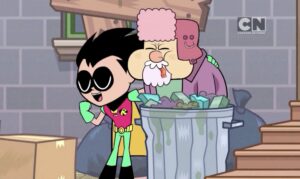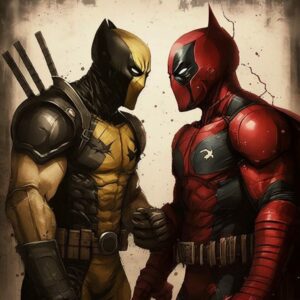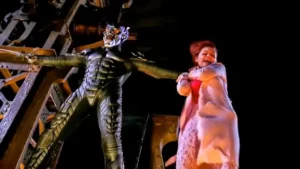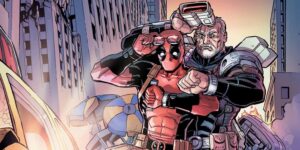This lesson is based on the excellent work of John Swinton. 2019. The Shadow vs. Batman: Contrasting Approach to Using Justice. In Brian O’Roark and Rob Salkowitz (Eds.), Superheroes and Economics: The Shadowy World of Capes, Masks and Invisible Hands. (pp. 111-123). Routledge. It is used by permission.
objectives
Demonstrate how to utilize isocosts and isoquants to find the most efficient output.
Explain how you can achieve an objective in different ways.
time needed
20-25 minutes.
materials
The ability to show the videos: Batman uses capital and Arrow uses labor.
Isocost/Isoquant graph
Production table:
Batman and Green Arrow: Isocost/Isoquant data
| B= $400 S = $100 | B = $100 S = $400 | Batman | Green Arrow | |
|---|---|---|---|---|
| Output | Labor (agents) | Capital (tools) | Total Cost | Total Cost |
| 5 | 1 | 16 | 2000 | 6500 |
| 5 | 2 | 8 | 1600 | 3400 |
| 5 | 4 | 4 | 2000 | 2000 |
| 5 | 8 | 2 | 3400 | 1600 |
| 5 | 16 | 1 | 6500 | 2000 |
overview
Isocosts and isoquants are rather sophisticated tools and students usually do not take to them quickly. The pair can be rather useful to help understand why an individual or a firm choses to produce with the mix of inputs that they do.
Most students know that there are lots of different superheroes who each have their own skill set. Supergirl is strong and can fly. Flash is really fast. Aquaman can survive underwater. Dr. Strange can harness magic. These heroes use their powers to help protect the world. Other heroes have very similar skill sets. Take Batman and Green Arrow. These characters appeared around the same time, Batman in 1939 and the Arrow in 1941. They are both clever, and are usually depicted as children of rich industrialists; however, neither has superpowers. What makes them interesting in this context is that they have very different methods to fight crime.
Batman doesn’t really have many friends. He has a small support staff including Alfred, various Robins, Harold Alnut (in the comics) and Lucius Fox (in the movies). In some Batman stories he doesn’t interact with this crew at all. Batman relies upon his incredible intelligence, physical training, and most importantly, his technology. For Batman, solving crime is a capital intensive proposition.
Green Arrow, on the other hand, is a real people person. He’s got a cadre of devoted friends who do a lot of the legwork needed to solve a crime. Other than a quiver full of arrows and some martial arts, Arrow doesn’t have much in the way of technology or capital. He solves crimes in a very labor intensive way.
This is a perfect set up for applying the model to understand how the two heroes can be successful despite adopting very different methods. Armed only with isocosts and isoquants, we become the super sleuths trying to determine the best way to produce justice!
action
Before bringing up the topic of isocost and isoquant, ask students how heroes might differ in their approach to crime fighting. Are there any heroes who would prefer to work alone as opposed to working in a team? What about the difference between heroes with powers (Superman, Wonder Woman, the Hulk) and those without (Batgirl, Hawkeye, Nightwing).
Introduce two heroes: Batman and Green Arrow. Let students know that neither posses super powers and both appeared very early on in comic book history. Also, mention the two different approaches these heroes have for solving crimes. One is labor intensive, the other is capital intensive.
Now, begin to explain the isocost and isoquant model. In order to use the model it is important for students to understand the setting for the tools. So, begin by making sure students can answer the following questions:
•What are you producing?
•How will you produce?
WHAT:
In this case, heroes are capturing bad guys.
The isoquant is telling you what you are producing. For this exercise, the output is set equal to 5. The isoquant line will give us the various input combinations of labor and capital that can result in catching 5 bad guys. These two inputs will be the variables along the two axis of the model. (NOTE: In this example, labor is on the x-axis and capital is on the y-axis.)
HOW:
These two heroes go about capturing villains in different ways. One is labor intensive, the other is capital intensive. However, both heroes use at least a little of each. To answer the how to produce question, we want to find the optimal quantity of each input to maximize profit – in this case because we have a fixed output, maximizing profit equates to minimizing costs.
Show the two videos Arrow uses labor and Batman uses capital.
Ask students how the two heroes seem to differ in their approach to crime fighting. They should reference the number of people on Batman’s team (2) and Arrow’s team (5). Also, they should note the relative dependence on capital to do the crime fighting. Batman is using technology and a new Batmobile, while Arrow’s tech helps him find where the crime is taking place.
Finally, set up the isocost lines:
Each hero’s isocost line can be drawn based on the information in the table. Because Batman views labor as more expensive relative to capital ($400 for each unit of labor versus $100 for each unit of capital), the slope of his isocost line will be steep. Arrow looks at labor as relatively less expensive ($100 for each unit of labor versus $400 for each unit of capital) so his isocost line is flatter.
Make sure this is clear for students as it will eventually become fodder for understanding the slope of the isocost curve. Because Batman will hire less labor than capital at the perceived higher cost, the tangency of his isocost and isoquant curves occurs in the steeper portion of the isoquant curve.
Arrow looks at labor as relatively less expensive than capital so the tangency of his isocost and isoquant curves occurs in the flatter portion of the isoquant curve.
Now have students graph the curves. Given the data in the table, there will be a tangency at 2 units of labor and 8 units of capital for Batman, and a tangency at 8 units of labor and 2 units of capital for Arrow on the isoquant curve where output = 5.
Now that students have an idea of what this model is doing, introducing the equality of the marginal rate technical substitution (slope of the isoquant line) and the price of factor ratio (slope of the isocost) should be more intuitive.
A completed graph can be found here: Batman and Arrow Isocost / Isoquant graph.
discussion
The first question to ask is why the two heroes can end up producing the same output with different input mixes. The answer is that production can occur in multiple ways. Depending on how producers utilize their resources, and the competencies of those resources, it is possible to achieve an outcome in more than one way.
Now, focus on the tangencies of the isocost and isoquant curves.
Question: What do these tangencies mean in terms of production costs.
Answer: These are the lowest cost points for each hero.
Follow this up by emphasizing the importance of producing at those tangencies for firms who are trying to minimize the costs of production.
How firms mix labor and capital depend on the availability and cost of each.
Question: If you were Batman, how would the relative costs between labor and capital affect your decision to expand your crime fighting operations?
a. You would be prone to use more capital than labor..
b. You would be prone to use more labor than capital.
c. You would always work alone.
d. You would be on the lookout for replacement help as soon as your side-kick asked for a raise.
Answer: a. You would be more prone to look for capital alternatives as opposed to labor. It isn’t that you don’t hire any labor at all, rather you would choose to employ more of the relatively cheaper input. If your side-kick asked for a raise, it might be worth giving it to them depending on how much human capital they have built up working with you.
Question: In a country with lots of citizens, would you expect production to be more like that of Green Arrow or Batman?
Answer: Green Arrow, because he utilizes more labor. When you have more of a resource available, that resource tends to be relied upon for production. More labor typically means wages will be lower relative to the cost of capital.
Question: How does finding the tangency of the isocost and isoquant help Batman and Green Arrow fight crime?
a. The tangency yields the highest total revenue for the hero which yields the largest profit.
b. The tangency shows which input is more important for profit maximizing production.
c. The tangency shows how to produce the given output in the least costly way, helping the hero make the most out of their limited resources.
d. It doesn’t help at all. This model is only theoretical.
Answer: c. By producing the given output in the least costly way, it helps the hero make the most out of their limited resources. For firms producing a given amount of output, they need to minimize costs to maximize profits. Finding the tangency of the isocost and isoquant curves allow them to do this. The tangency has nothing to do with total revenue as it is showing the lowest cost way of producing output. Additionally, the tangency does not indicate which input is more important, only which is relatively less costly.





